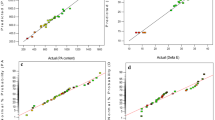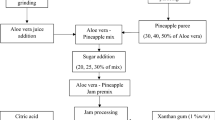Abstract
An optimization and multivariate accelerated shelf-life testing (MASLT) was demonstrated to develop a low glycemic (GI) whole jamun (Syzygium cumini L.) confection (WJC) with soft texture and fruity hedonics targeted for diabetic strata. The hydrocolloids viz., agar (1–3 g), pectin (1–3 g), and polydextrose (24–28 g) were optimized [mixture design (MD)] to obtain hydrocolloid mix (HM) with a soft texture. Next, whole jamun ingredients viz, jamun pulp (JP) (20–30 g), seed powder (JSP) (1–5 g), and HM (25–35 g) were optimized (MD + PCA) for satisfactory texture, total polyphenolic content (TPC), and fruity hedonics. The optimized WJC was assayed for GI and modelled by univariate kinetics and MASLT (10–45 °C/75% humidity/120 days). Using MASLT, the collated effects of quality attributes (anthocyanin content, TPC, moisture, hardness, and total color change) were extracted as principal components to estimate new stability parameters viz, multivariate rate constants (km), acceleration factors (\( \alpha_{m}^{T} \)), activation energy (Eam), and cut-off criterion. The optimized WJC contains 2.3 g agar, 1.9 g pectin, 27.2 g polydextrose, 26.4 g JP, and 2 g JSP and had satisfactory hardness (1007 g), TPC (2.8 mg gallic acid equivalents/g), and low GI value (48.6). The zero-order kinetic fitting of univariate versus MASLT resulted in \( \alpha_{(45,10)}^{T} \) , Ea, and shelf life (10 °C) of 7.8 versus 6.2, 43.81 versus 39.22 kJ/mol and 175 versus 186 days, respectively. MASLT simplified the kinetic interpretations to a single variable by collating the useful information from critical quality parameters and predicted shelf life precisely than univariate kinetics.




Similar content being viewed by others
Abbreviations
- a*:
-
Redness
- E a :
-
Activation energy
- AC:
-
Anthocyanin content
- b*:
-
Yellownes
- CS:
-
Cohesiveness
- db:
-
Dry basis
- GAE:
-
Gallic acid equivalents
- GDRI:
-
Glucose dialysis retardation index
- GI:
-
Glycemic
- HD:
-
Hardness
- HM:
-
Hydrocolloid mix
- JP:
-
Jamun pulp
- JSP:
-
Jamun seed powder
- k :
-
Kinetic rate constant
- L*:
-
Lightness
- LSD:
-
Least significant difference
- LDPE:
-
Low-density polyethylene
- MD:
-
Mixture design
- MC:
-
Moisture content
- MASLT:
-
Multivariate accelerated shelf-life testing
- \( \alpha_{m}^{T} \) :
-
Multivariate acceleration factors
- E am :
-
Multivariate activation energy
- t cm :
-
Multivariate cut-off criterion
- k m :
-
Multivariate rate constants
- ANOVA:
-
One-way analysis of variance
- PCA:
-
Principal component analysis
- SG:
-
Springiness
- α T :
-
Temperature acceleration factor
- ΔE:
-
Total color change
- TDFC:
-
Total dietary fiber content
- TPC:
-
Total polyphenolic content
- WJC:
-
Whole jamun confection
References
Ahmed F, Urooj A (2010) Effect of Ficus racemosa stem bark on the activities of carbohydrate hydrolyzing enzymes: an in vitro study. Pharm Biol 48:518–523
AOAC (2012) Official methods of analysis, 19th edn. Association of Official Analytical Chemists, Washington, DC
Bali S (2007) A process for the manufacture of herbal candy. Indian Patent Application No. 210,880
Chau CF, Chen CH, Lin CY (2004) Insoluble fiber-rich fractions derived from Averrhoa carambola: hypoglycemic effects determined by in vitro methods. LWT-Food Sci Technol 37:331–335
Chethan S, Sreerama YN, Malleshi NG (2008) Mode of inhibition of finger millet malt amylases by the millet phenolics. Food Chem 111:187–191
Chung HJ, Lim HS, Lim ST (2006) Effect of partial gelatinization and retrogradation on the enzymatic digestion of waxy rice starch. J Cereal Sci 43:353–359
Howlader MZH, Biswas SK (2009) Screening for nutritionally rich and low glycemic index Bangladeshi rice varieties. Final Report CF 6:1–34
Karasu S, Doğan M, Toker ÖS, Caniyilmaz E (2014) Modeling of rheological properties of mellorine mix including different oil and gum types by combined design, ANN, and ANFIS models. Turkish J Agric For 38:745–757
López G, Ros G, Rincón F, Periago MJ, Martinez MC, Ortuno J (1996) Relationship between physical and hydration properties of soluble and insoluble fiber of artichoke. J Agric Food Chem 44:2773–2778
Mitchell J (2003) Food texture and viscosity: concept and measurement. Int J Food Sci Technol 38:839–840
Pedro AM, Ferreira M (2006) Multivariate accelerated shelf-life testing: a novel approach for determining the shelf-life of foods. J Chemometr 20:76–83
Raju PN, Pal D (2011) Effect of bulking agents on the quality of artificially sweetened misti dahi (caramel colored sweetened yoghurt) prepared from reduced fat buffalo milk. LWT-Food Sci Technol 44:1835–1843
Savant VD (2010) Jelly confectionery products having a stabilizer/fiber blend. U.S. Patent Application No. 13/989, 106
Sehwag S, Das M (2014) Nutritive, therapeutic and processing aspects of Jamun, Syzygium cumini (L.) Skeels: an overview. Ind J Nat Prod Resour 5:295–307
Sehwag S, Das M (2016a) Composition and functionality of whole jamun based functional confection. J Food Sci Technol 53:2569–2579
Sehwag S, Das M (2016b) Composition and antioxidant potential of jamun (Syzygium cumini L.) from eastern India. Asian J Biochem Pharm Res 6:106–121
Singh JP, Kaur A, Singh N, Nim L, Shevkani K, Kaur H, Arora DS (2016) In vitro antioxidant and antimicrobial properties of jambolan (Syzygium cumini) fruit polyphenols. LWT-Food Sci Technol 65:1025–1030
Singh B, Singh JP, Kaur A, Singh N (2018) Phenolic compounds as beneficial phytochemicals in pomegranate (Punica granatum L.) peel: a review. Food Chem 261:75–86
Somboon N, Karrila TT, Kaewmanee T, Karrila SJ (2014) Properties of gels from mixed agar and fish gelatin. Int Food Res J 21:485–492
Upadhyay R, Mishra HN (2015a) A multivariate approach to optimise the synergistic blend of oleoresin rosemary and ascorbyl palmitate added into sunflower oil. Int J Food Sci Technol 50:974–981
Upadhyay R, Mishra HN (2015b) Multivariate analysis for kinetic modeling of oxidative stability and shelf life estimation of sunflower oil blended with sage extract under Rancimat conditions. Food Bioprocess Tech 8:801–810
Upadhyay R, Mishra HN (2016) Multivariate optimization of a synergistic blend of oleoresin sage and ascorbyl palmitate to stabilize sunflower oil. J Food Sci Technol 53:1919–1928
Upadhyay R, Nachiappan G, Mishra HN (2015) Ultrasound-assisted extraction of flavonoids and phenolic compounds from Ocimum tenuiflorum leaves. Food Sci Biotechnol 24:1951–1958
Acknowledgments
The authors acknowledge the financial support from Department of Biotechnology, Government of India (Grant No. BT/FNS/01/05/2008). The in vivo GI studies carried out by Food Chemistry and Nutrition Laboratory, Defense Food Research Laboratory (Mysore), India is highly acknowledged. The authors declare no conflict of interest.
Author information
Authors and Affiliations
Corresponding author
Electronic supplementary material
Below is the link to the electronic supplementary material.
Rights and permissions
About this article
Cite this article
Sehwag, S., Upadhyay, R. & Das, M. Optimization and multivariate accelerated shelf life testing (MASLT) of a low glycemic whole jamun (Syzygium cumini L.) confection with tailored quality and functional attributes. J Food Sci Technol 55, 4887–4900 (2018). https://doi.org/10.1007/s13197-018-3423-4
Revised:
Accepted:
Published:
Issue Date:
DOI: https://doi.org/10.1007/s13197-018-3423-4




